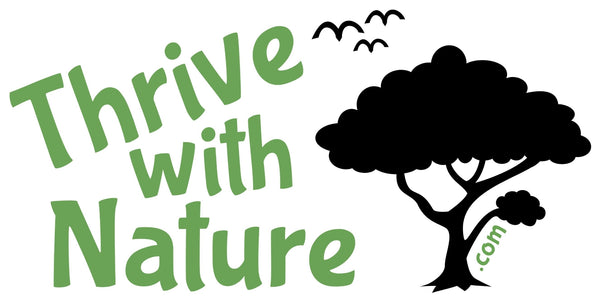This article was published in the BCTRA 2018 spring newsletter (British Columbia Therapeutic Recreation Association).

It is not half so important to know as to feel. Rachel Carson
You don’t need to be a gardener or naturalist to facilitate therapeutic garden and nature programs. As a therapeutic recreation specialist (or other healthcare professional), if you have a sense of curiosity and willingness to follow your participants’ lead (so important!), you’re ready to facilitate simple, effective nature-based programs.
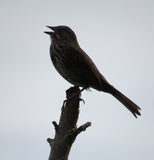 The simplest programming ideas can be the most effective: “Often a session developed around sensory stimulation and a greater awareness of one’s surroundings can be more effective than a gardening project with many steps that results in something to carry out the door” (Haller & Kramer, 2006).
The simplest programming ideas can be the most effective: “Often a session developed around sensory stimulation and a greater awareness of one’s surroundings can be more effective than a gardening project with many steps that results in something to carry out the door” (Haller & Kramer, 2006).
What nature-based programming do you already do with your participants? What might you add?
I’ve got eight nature-based programs to recommend to you, which include bringing nature to your participants and bringing your participants to nature.
These eight programs are based on the following research about:
- noticing nature,
- creating a healthy human habitat, and
- offering meaningful pleasures of daily life.
The Evidence Base
Noticing Nearby Nature
Whether or not you are a nature lover, research suggests that we all benefit from actively noticing nearby nature, including improvements in mood and sense of connectedness (Passmore & Holder, 2016).
I showed photos of our window views to a group of my care home colleagues and one of them asked, “Are these photos from our building?!” “Yes,” I replied, “They are.” Seeing the photos helped them realize how much greenery was visible to them during their work day.
“Exploring nature… is largely a matter of becoming receptive to what lies all around you. It is learning again to use your eyes, ears, nostrils and finger tips, opening up the disused channels of sensory impression” (Carson, 1965).
Creating a Healthy Human Habitat
A strong body of research shows that green environments are essential to human functioning and to a healthy human habitat (Kuo, 2010). This research supports the Eden Alternative’s recommendation of continuing contact with pets, plants and people of all ages as essential elements of a human habitat.
We develop stronger social ties, experience better mental health and cognitive function, and are more physically active and independent (to name just a few of the many benefits of greenery!) (Kuo, 2010).
Offering Meaningful Pleasures
Research shows that older people, as well as people of any age who are ill or injured or have recently experienced a life-threatening event, tend to perceive life differently from younger, healthier people (Gawande, 2014). The difference? ‘My days are numbered’ vs. ‘I’ve got my whole life ahead of me.’
In Being Mortal, Gawande explains that when we perceive our life as finite and uncertain, we are much less concerned with achieving future goals, and much more attuned to being present in the moment. Along with this, we value companionship, especially of people who are dear to us. We want to be seen and heard and acknowledged. To do for ourselves instead of lapsing into learned helplessness. We value choice and want to have control over our lives. We value everyday pleasures.
Is it any wonder that plants, animals and birds bring joy? They’re so full of life in the moment. We’re less likely to experience loneliness, helplessness or boredom when fully engaged with nearby nature.
3 Programs to Bring Nature to Your Participants
The nature programming you offer to your participants doesn’t need to be complex or require extreme preparation. Focus on daily life. Offer choices. Include many expressions of nature. And be fully present to see and hear the unique individuals you serve.
The first three programs bring nature to your participants where they are. Once a therapeutic bond has developed, your participants are more likely to accept invitations for you to bring them to nature, as described in the subsequent five programs.
Arranging Flowers

Offer a variety of flowers in a bucket within easy reach of your participant and focus on their response. Follow their lead in what step to do next. Offer a choice of vases (plastic if safety is an issue). Help only when needed: a bit of struggle is generally useful; watch for signs of stress and offer help only if needed. If giving them scissors presents a safety issue, ask them to hold each flower while you cut the stem.
Arranging flowers can be a one-to-one situational assessment and assist in developing a therapeutic bond, especially with a new participant. A follow-up question or two can reveal other nature activities that would be beneficial, of interest, and within the participant’s capabilities.
Whether or not the flowers end up in a vase is not important. Enjoyment is the goal.
Click here to learn about the many health and well-being benefits of flower arrangements.
Arranging Leaves and Botanicals

When flowers aren’t available, or to provide seasonal variety, offer leaves and other natural items to arrange into a pleasing design. Then photograph each creation. Once printed the pictures can be offered to the participant for display.
Coloured paper or table cloths provide a choice of backgrounds. Leaves can be pressed in a book and botanicals (seeds, cones, twigs, bark, etc.) can be arranged in a dish or basket. These simple activities put the focus on the sensory qualities of the plants and allow for curiosity and sharing stories, knowledge and memories.
Caring for Indoor Plants
Your participants may have experience caring for indoor plants, even if you don’t. Spend time looking at a plant together, focus on sensory qualities and explore the plant’s life with curiosity; expert knowledge can actually get in the way of a therapeutic experience.
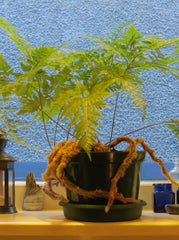 You might leave a plant for your participant to care for, or pick up a plant from a nearby common area and bring it to your participant to engage with. Touch it, look closely at it, water if the soil is dry, tidy up brown leaves or wayward growth, top up with soil if needed. Caring for a living plant can bring a sense of purpose and increased independence.
You might leave a plant for your participant to care for, or pick up a plant from a nearby common area and bring it to your participant to engage with. Touch it, look closely at it, water if the soil is dry, tidy up brown leaves or wayward growth, top up with soil if needed. Caring for a living plant can bring a sense of purpose and increased independence.
Safety note: Some indoor plants are toxic if chewed. The most common toxic plants I’ve seen brought into care facilities are dumbcane (Dieffenbachia) and flamingo lily (Anthurium). Click here for a printable poster to alert staff to remove these two plants. Place this poster where only staff will see it.
Non-toxic house plants include ferns, African violet, spider plant, jade plant, dragon tree (Dracaena), palms, Hoya, coleus, begonia and Christmas cactus. Try an online image search if any are unfamiliar.
5 Programs to Bring Your Participants to Nature
Once a therapeutic bond is established, your participants are more likely to accept invitations to go with you to enjoy nature (one-to-one or in a group).
Enjoying a Window View

Window views with greenery and sky are an often-overlooked resource. Encourage your program participant(s) to join you at the nearest green (or blue) window view. Look out together and let your eyes wander where they will. Explore the patterns and movements of tree branches or leaves, and the play of light. Notice how your body responds. Take a few minutes to slow down and just be together.
A few minutes of a nature view can lessen pain, anxiety and stress and improve mood. Encourage your participant to enjoy window views as a daily routine.
Venturing Outdoors for a Slow, Sensory Stroll
Some participants are eager to get outdoors and others will agree to accompany you only after several nature-based visits indoors. I found that ‘Let’s go look at the garden’ is generally better received than an invitation to garden. Provide reassurance that you’ll bring them back inside when they wish.
A slow sensory stroll can be a silent interactive experience or it might prompt conversation and stories. Don’t feel you need to keep the conversation going; silent appreciation leaves room for deeper experience (and birds are more likely to appear). Follow your participant’s lead, whether it’s a verbal request to go closer to a plant, a pointed finger, or a slight turn of their head in the direction they’d like to go.
If your participant can’t reach the plants, pick pieces to hand to them or to place in their lap. Touch, smell, listen. Look closely and linger. Just a few minutes enjoying nature can calm and refresh, as well as provide a buffer against upcoming stress.
If you don’t have a garden or park, enjoy nearby street trees, shrubs, sky, and other people’s yards. Slowing down reveals much that we don’t see when we’re focused on getting to a destination.
Discovering Your Participants’ Gardening Interests and Experience
You may find out from a slow sensory stroll that your participant has gardening experience. They might share stories or show signs of wanting to garden.
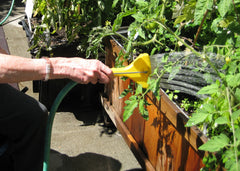 I can’t tell you how many times people have refused invitations to garden, but once they are out in the garden, they can’t seem to help themselves. They watch other people with their hands in the soil, or they see a weed that just has to come out. It’s delightful to watch the gardening impulse emerge and grow. Start with a sensory stroll and magic may happen.
I can’t tell you how many times people have refused invitations to garden, but once they are out in the garden, they can’t seem to help themselves. They watch other people with their hands in the soil, or they see a weed that just has to come out. It’s delightful to watch the gardening impulse emerge and grow. Start with a sensory stroll and magic may happen.
Many of my participants were keen to garden if I provided them with supplies, tools and muscle as required. I welcomed them teaching me how they like to garden. Be upfront with them if you’re a novice gardener and let them be the expert.
A garden can grow from one person asking to plant bean seeds. It has happened.
Introducing Garden Activity Signs
 Extend your reach to more garden visitors by creating or buying garden activity signs. Imagine yourself in the garden holding a sign that says ‘Smell Me’. Even if you had no idea which flowers smelled good in your garden, you could stroll around with a participant testing out the flowers by smelling them. When you find one that smells good, place the sign so that other people coming out to the garden will be encouraged to enjoy the fragrant flower.
Extend your reach to more garden visitors by creating or buying garden activity signs. Imagine yourself in the garden holding a sign that says ‘Smell Me’. Even if you had no idea which flowers smelled good in your garden, you could stroll around with a participant testing out the flowers by smelling them. When you find one that smells good, place the sign so that other people coming out to the garden will be encouraged to enjoy the fragrant flower.
You and your participant might choose to touch leaves and install a ‘Touch Me’ sign on a plant with a soft or interesting texture. Or you might see a marigold with wilted flowers and add a ‘Remove Seed Pods’ sign. Together, you and your participant are giving other garden visitors permission to enjoy and care for the garden.
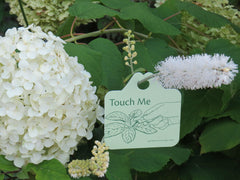
In my efforts to encourage more nature programming, I created a set of twelve garden activity signs, which are available to purchase individually or as sets. Six of the signs show sensory invitations and six more show common hands-on gardening tasks. If your participants have visual impairments, a set of 12 plantable signs is a good place to start. If their vision is good, 12 hang tags work well.
Click here to see the garden activity signs.
Exploring Virtual Nature
On days when the weather doesn’t allow for going outdoors, virtual nature offers benefits (though there’s nothing quite like living nature). Encouraging interactive discussion makes pictures and videos more personal and meaningful.
If Wi-Fi is available the choices are almost unlimited. YouTube videos provide gardening instruction, show time-lapse and real-time nature scenes, and almost any garden or nature subject your participants would like to see. Involve your participants in choosing the topics, and in sharing their stories and knowledge before and after each short video.
Even without Wi-Fi, there are many choices. Find videos at your local library. Better yet, share slideshows or videos of your vacations and adventures in nature. When I shared my slideshow from paddling the Bowron Lakes circuit, it prompted stories from participants who had been there or paddled in other locations. I heard from participants who don’t attend garden programs but were keen to share their nature adventures.
Even a mural or a piece of artwork hanging on a wall can take us into another world if we imagine ourselves there. Go for a playful wander together in a nature scene.
Next Steps
Walk around your care home, day centre or clinic with fresh eyes. Notice nature in its many forms, both indoors and out, and ask yourself how you might encourage your participants to engage with and derive more benefit from the plants, animals and living nature that surrounds them.
Which of these eight nature programs will you offer to your participants?
Here's a short and simple approach for bonding with your clients while improving their mental well-being.
References
Carson, R. (1965). Sense of Wonder. New York: Harper & Row.
Gawande, A. (2014). Being Mortal: Medicine and What Happens in the End. Canada: Doubleday.
Haller, R., & Kramer, C. (2006). Horticultural Therapy Methods. New York: Haworth Press.
Kuo, F. (2010). Parks and Other Green Environments: Essential Components of a Healthy Human Habitat. Retrieved from http://bit.ly/1Aw5gi0
Passmore, H.-A., & Holder, M. (2016). Noticing nature: Individual and social benefits of a two-week intervention. The Journal of Positive Psychology, 1–10. Retrieved from http://bit.ly/2CREzbK
